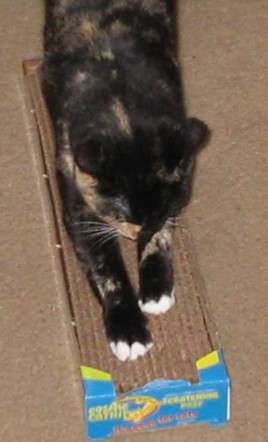Should You Declaw Your Cat?

There are many reasons why people ask their veterinarian to declaw their cat. Anyone who has ever lived with a cat knows that cats like and need to scratch (which my expensive stereo speakers can also attest to). Some cat owners get their cat declawed because they don't want their belongings scratched up and ruined. Some pet owners don't want their children or themselves scratched by their cat. Some pet owners are told by their landlords that in order to keep their cat they must get the cat declawed. And some people have compromised immune systems and need to ensure that they don't receive any cat scratches and they have their cats declawed to prevent infection.
The question is whether or not declawing a cat is humane and in the cat's best interest. The medical term for declawing is onychectomy, although most people don't use this term. Declawing is the term most commonly used, but the term declawing isn't really accurate for what this procedure entails. According to Atwood-Harvey (2005), declawing is not the removal of only the cat's claws. Rather, it is the same as if you had your first knuckle (closest to your nails) of each finger chopped off. So, it isn't just the claw that is removed, but the entire first joint as well.
Most veterinarians agree that the procedure is very painful for the animal, however, if one was in a situation in which the choice was either declawing the cat or the animal would lose its home and possibly its life, such as when a landlord insists on animals being declawed, or when the cat owner's immune system is compromised, then it might be best to have the procedure done. I do know of at least one cat that has been declawed and the cat appears to be very happy. However, I have never had a cat declawed and probably never would. Years ago I did adopt a cat from an animal shelter that was already declawed. The cat seemed happy, although she did have litter box issues (which may have had nothing to do with the fact that she was declawed). However, research has suggested that declawed cats may be more prone to problem litter habits than cats who still have their claws (Bennet & Houpt, 1988). In general, it is best not to declaw your cat unless you have to do so in order to prevent the cat from becoming homeless. Thankfully there are alternatives to declawing.
Alternatives to Declawing Your Cat
You could keep the cat's nails trimmed short. Now I realize that it isn't that easy to trim your cat's nails, but it can be done. Also, most veterinarians will do it for free during the cat's yearly examination or for a minimal fee at other times. If your cat is scratching up the furniture you could get him or her a scratching post. There are various kinds, but the ones that I've had the most success with are flat cardboard and usually come with a little bag of catnip. Smartycat and Cosmic Catnap brands are the kind I've seen most often, but I'm sure there are others available. When I bring a couple of these home from the store my cats just go crazy with excitement. It is their very favorite item. Unfortunately, because they are made out of cardboard they do have to be replaced every so often. You can usually buy them starting at about $5.99. In general, the key is to find a scratchpost your cat likes better than your carpet or your furniture.
A cat using her cardboard scratchpost instead of the furniture.

Another alternative is to apply Soft Paws to your cats nails. Soft Paws are vinyl caps that
are placed over your cat's nails. You can apply them to your cat yourself, or most veterinarians will
place them on your cat for you if you feel you are unable to do it yourself. They are reported to last
for about 4 to 6 weeks and then need to be reapplied, but they are relatively inexpensive. I've not actually used them, but supposedly they
work very well. For more information please visit the Soft Paws Web site.
Atwood-Harvery, D. (2005). Death or declaw: Dealing with moral ambiguity in a
veterinary hospital.
Society and Animals, 13(4), 315-342.
Bennet, M. & Houpt, K. A. (1988). Effects of declawing on feline behavior.
Companion Animal Practitioner, 2, 7-12.
